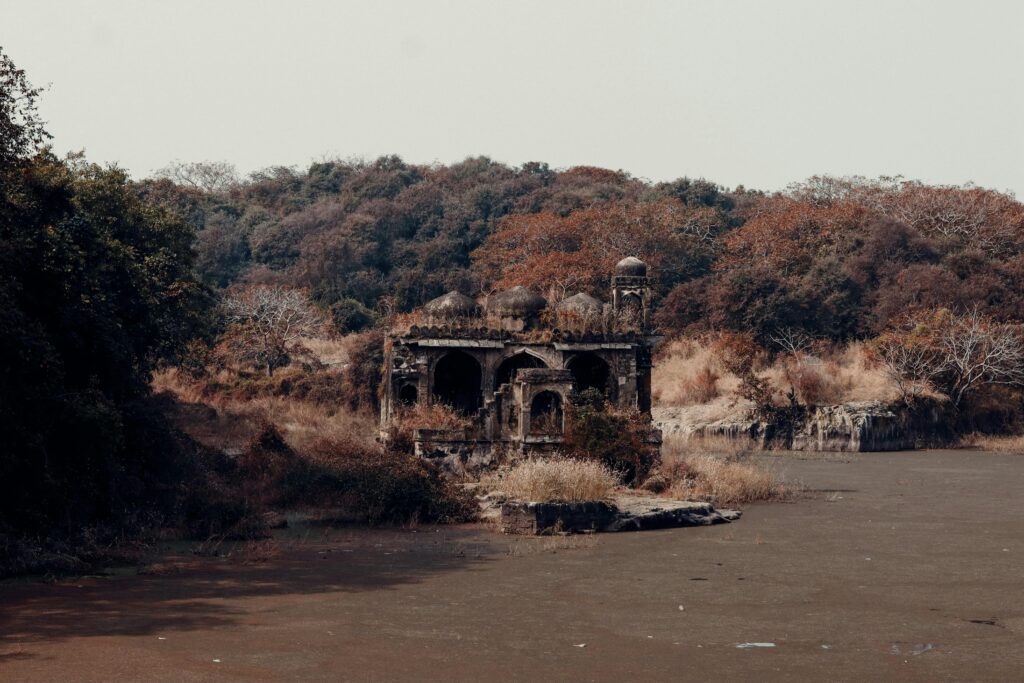
Table of Contents
Introduction
The Ranthambore National Park is one of India’s most famous wildlife parks, situated in the Sawai Madhopur district of Rajasthan.
Covering a huge area of 1,334 square kilometers, this sanctified area is famous for having a healthy population of tigers, distinct topography, and great biodiversity.
Both a wildlife sanctuary and a national park, Ranthambore is unique in India’s conservation past. In addition to its function of saving endangered animals, the park is also rich with cultural heritage because of its medieval fort, temples, and ruins that are spread all over the forest.
Ranthambore today is a major hub for wildlife buffs, researchers, and photo enthusiasts. Its harmony of heritage, nature, and wildlife ranks it among the most interesting wildlife reserves in the world.
History and Formation of Ranthambore National Park
Ranthambore National Park has a royal past in the history of Rajasthan, having been utilized as a personal game reserve by the Maharajas of Jaipur.
Royalty and British officers hunted tigers, leopards, and other large game animals here in the 19th and the early 20th century.
The region was proclaimed the Sawai Madhopur Game Sanctuary in 1955. It was later recognized under Project Tiger as one of India’s initial tiger reserves in 1973.
It was officially formed as Ranthambore National Park in 1980, providing total protection to its wildlife.
The park not only saved its fauna but also protected its ruins, temples, and beautiful Ranthambore Fort, thus constituting a mix of heritage and conservation.
Today, it is a success tale of how a hunting ground was converted into a world-renowned wildlife sanctuary.
Geography and Landscape of Ranthambore
Located at the boundary of the Vindhya and Aravalli hills, Ranthambore National Park is blessed with hilly terrain, dry deciduous forests, and open meadows.
The park has lakes, streams, and valleys where a variety of flora and fauna thrive.
Some of the salient features are:
Padam Talao and Raj Bagh Lake, which host animals like tigers, crocodiles, and migratory birds.
Dense forests and open grasslands, providing a balance between dense cover and open hunting grounds for predators.
Dry climate, sculpting the flora of the park with species such as dhok trees, banyans, and neem.
This distinctive ecosystem renders Ranthambore not only a national park, but a living example of India’s diverse landscapes and their coexistence with wildlife.
Wealthy Wildlife of Ranthambore National Park
The pride of Ranthambore National Park is the Bengal tiger. Famous for being relatively easy to see, Ranthambore now ranks among the world’s top destinations to see tigers in the wild.
Yet, the park also houses an incredible variety of other animals:
Predators: Leopards, caracals, hyenas, and jackals

Herbivores: Sambar deer, chital, nilgai, and wild boars
Reptiles: Marsh crocodiles, monitor lizards, and snakes

Birdlife: More than 320 species of birds, including migratory birds like painted stork, steppe eagle, and crested serpent eagle

This vast variety makes Ranthambore not merely a tiger reserve—it is an entire wildlife sanctuary, giving a glimpse into the ecological wealth of India.
Safari Experience in Ranthambore National Park
No visit to Ranthambore National Park is complete without having a wildlife safari experience. The park has two primary types of safaris:
Jeep Safari: Six-seater jeeps enabling closer proximity and more conducive picture-taking.
Canter Safari: Open buses that take a maximum of 20 individuals, good for groups.
The park is spread across various zones, each with distinct landscapes and possibilities of tiger and wildlife sightings.
Well-visited zones such as 3 and 4 are famous for the sighting of tigers around lakes and ruins.
Strict regulations are there for the protection of the animals to ensure eco-tourism. Twice-daily safaris, in the morning and late afternoon, when the animals are at their most active, are done.
This well-organized system makes Ranthambore both tourist-friendly and conservationist-friendly, upholding its status as a responsible wildlife sanctuary.
Ranthambore Fort: A Heritage Inside the Park
It is not only its wildlife that makes Ranthambore National Park special, but also its rich heritage. The Ranthambore Fort, a World Heritage Site recognized by UNESCO, is located within the park.
Constructed in the 10th century, the fort was once used as a fortress for the Chauhan rulers and, after that, by the Mughals.
The fort provides vistas of the park and is encircled by temples, palaces, and ruins that impart historical significance to nature.
Ranthambore is therefore more than a national park—it is a museum of history, culture, and ecology in action.
7 Mind-Blowing Facts About Ranthambore Wildlife Sanctuary
World-Famous Tiger Sightings
Ranthambore National Park is among the top spots in the globe to observe tigers in their natural habitat.
Compared to other tiger reserves where it’s a rare occurrence, Ranthambore has relatively greater opportunities thanks to its open terrain and smaller territories.
Every tiger in the park has been cataloged and assigned a special identity, like Machhli, the famous tigress, who was a worldwide sensation.
Wildlife photographers and buffs from all over the world come to photograph these magnificent animals.
The adventure of seeing a tiger step out of the ruins or amble along the lakeside makes Ranthambore an experience in a lifetime.
Varied Ecosystem with Dry Forests and Wetlands
Perhaps the most intriguing feature of Ranthambore National Park is the diversity of its ecosystems.
The park contains dry deciduous forests, grasslands, and wetlands all in a relatively small space.
The combination is conducive to an extraordinary number of species.
The dry forests offer homes to tigers, leopards, and hyenas.
The wetlands such as Padam Talao and Rajbagh Lake draw marsh crocodiles, migratory birds, and grazing animals.
The grasslands are a perfect place for grazing sambar deer and chital.
Such diversity makes Ranthambore not only a tiger reserve, but a full-fledged wildlife sanctuary where a number of species live in harmony.
Ranthambore Fort – A UNESCO World Heritage Site Inside the Park
In contrast to most national parks, Ranthambore stands out from the rest since it accommodates the Ranthambore Fort, a UNESCO World Heritage Site.
Constructed in the 10th century, the fort occupies a hilltop within the park and has a commanding view of the thick forests below.
The fort is ringed by temples, mosques, palaces, and ancient ruins, thus combining history with wilderness.
Tigers are frequently seen roaming at the foot of the fort, creating a dreamlike combination of heritage and wildlife.
This sets Ranthambore apart from other Indian wildlife sanctuaries—where else will you witness a tiger alongside a thousand-year-old fort?
Large Area Spanning 1,334 Square Kilometers
Ranthambore National Park and the sanctuaries surrounding it cover a humongous space of 1,334 square kilometers. This comprises Ranthambore itself, the Mansingh Sanctuary, and the Kaila Devi Sanctuary.
This vastness permits wildlife to roam unrestrained while presenting visitors with varied landscapes to discover.
There are zones that are covered with lakes and marshes, and others that are rocky deserts. Every safari zone provides a different opportunity to see various animals, ranging from elusive leopards to flocks of migratory birds.
The vast area guarantees that Ranthambore is not only a national park, but one of the largest and most important wildlife sanctuaries in Rajasthan.
Ancient Banyan Trees and Rich Flora
Besides wildlife, Ranthambore also boasts of ancient vegetation. There are some banyan trees within the park that are estimated to be centuries old, thus acting as living witnesses to the history of the area.
The second-largest banyan tree in India is found within Ranthambore, covering large tracts and offering shade to tens of thousands of animals.
Vegetation of the park is dominated by dhok trees, which cover almost 80% of the forest. Other species such as neem, peepal, and mango trees provide diversity.
The rich vegetation nourishes the intricate ecosystem of the wildlife sanctuary by providing food and shelter to both herbivores and carnivores.
Birdwatcher’s Paradise with 320+ Species
Though Ranthambore is renowned for its tigers, it is also paradise for bird watchers. The national park is a habitat to more than 320 species of birds, and hence it is a prime destination for ornithologists and photography enthusiasts.
Painted stork, black stork, and steppe eagle migrate to the park during winter.
Egrets, herons, and kingfishers are encountered near the lakes.
Raptors such as owls, hawks, and serpent eagles glide high above the woods.
This diversity makes Ranthambore one of the only few national parks in India that provide sightings of big cats as well as world-class birdwatching.
A Unique Mixture of Heritage, Nature, and Wildlife Tourism
What really distinguishes Ranthambore National Park is its capacity to merge heritage, nature, and wildlife in a single destination. There are few wildlife sanctuaries on earth that provide this sort of combination:
Historical depth is offered through ancient ruins, temples, and forts.
Tigers, leopards, and varied wildlife provide exciting confrontations.
Lakes, forests, and landscapes provide natural splendor.
This ideal mixture has turned Ranthambore into a favorite among visitors as well as a worldwide icon of India’s conservation triumph. Tourists don’t merely behold animals; they enter a living brocade of history and nature sewn together.
Best Time to Visit Ranthambore National Park
Selecting the optimum time to travel to Ranthambore National Park can be a big difference in terms of your wildlife experience.
As the park is situated in Rajasthan’s semi-arid region, its climate features hot summers, pleasant winters, and a seasonal monsoon. The knowledge of these seasons makes it easier for tourists to plan their safari.
Winter (October to March):
This is the best time to visit Ranthambore National Park. The climate is pleasant, averaging 10°C to 25°C, making safaris comfortable.
Animals are spotted quite often as they sit in the sun or congregate near water bodies. Migratory birds also come during this period, making it suitable for birders.
Summer (April to June):
Rajasthan’s summers are blazing, with temperatures reaching 45°C. But this is the best time for tiger spotting.
As lakes dry up, tiger and other game animals come close to watering spots and lakes such as Padam Talao and Rajbagh Lake. Summer is exciting for wildlife photographers in spite of the heat.
Monsoon (July to September):
During the monsoon period, the park is closed because of excessive rainfall and safety risks.
But forests and sanctuaries around it become lush green, filling the air with a refreshing environment. The park tends to open in October as the tourist season picks up.
Therefore, for the majority of tourists, October to March is the most pleasant and satisfying time. But for those interested in tiger sightings, the summer months can also be enchanting.
And finally, every season presents a different aspect of the beauty of this wildlife haven.
Safari Experience at Ranthambore National Park
A trip to Ranthambore National Park is incomplete without experiencing its famous wildlife safaris. The park offers both jeep safaris and canter safaris, which take visitors deep into the forest zones for a chance to witness its diverse wildlife and breathtaking landscapes.
Jeep Safari (Gypsy):
A 6-seater open jeep is suitable for small groups and photographers. It facilitates more flexibility in driving down narrow forest tracks and enhances the possibility of nearer wildlife encounters. Jeep safaris are very much in demand for their closeness and mobility.
Canter Safari:
A bigger open vehicle with approximately 20 seats, canter safaris are best for larger groups. They use the same routes as jeeps but offer a more communal experience. Canter safaris are ideal for budget travelers or families.
Safari Timings and Zones
Safaris are organized twice a day: early morning and evening. The times are adjusted according to the season so that they coincide with sunrise and sunset.
Ranthambore is split into several safari zones (from Zone 1 to Zone 10), each possessing distinct landforms and wildlife habitats.
Zone 1–5: These premium zones provide more opportunities for spotting a tiger.
Zone 6–10: Similarly diverse in terms of wildlife but not as populated, which makes them suitable for those who require peace and seclusion.
Wildlife Encounters During Safari
Though the Bengal tiger is the main act, safaris in Ranthambore also expose one to a wealth of wildlife.
Leopards, striped hyaenas, sloth bears, marsh crocodiles, and various species of birds are commonly seen.
The excitement of sitting motionless in the jungle, tracking fresh pugmarks, and eventually watching a tiger step out of the undergrowth is a memory ingrained for life.
Rules and Conservation Efforts
Safari tours are strictly controlled by the Forest Department to maintain minimum disturbance of animals.
The park has a zonal safari system to manage tourist entry and prevent overcrowding in sensitive zones.
These attempts help maintain the balance between tourism and conservation so that Ranthambore can continue to be a healthy and vibrant wildlife sanctuary for generations to come.
The safari adventure is not merely a matter of seeing animals—it is about immersing yourself in the unadulterated beauty of the jungle, inhaling the aroma of the forest, and hearing the voices of the wild. It is here that tourists bond with nature and understand how crucial it is to conserve such remarkable national parks.
Conclusion
Ranthambore National Park is so much more than an ordinary tiger reserve—it is an eternal haven where history, culture, and wildlife blend harmoniously.
Situated in Rajasthan, this incredible national park has become the emblem of India’s conservation triumph and a haven for numerous species that flourish within its rich and varied ecosystem.
From its fabled tiger spottings to its colorful birdlife, from the towering banyan trees to the eerie remains of Ranthambore Fort, each turn of this land has a tale to tell that fuses nature with heritage.
With its unique position of being one of India’s most iconic wildlife sanctuaries, Ranthambore is deeply in the hearts of travelers, naturalists, and conservationists.
What makes it stand out from other parks is its surreal capability of providing views of the mighty Bengal tiger alongside ancient fortresses and temples.
The tourists in this place do not just enjoy a safari; they become a part of a living testament centuries old, merging the natural and cultural heritage of Rajasthan.
In an era where urbanization and environmental challenges continue to grow, places like Ranthambore National Park remind us of the importance of protecting our wild spaces.
The park’s vast landscapes, diverse flora, and rare fauna underscore the delicate balance of ecosystems, while its historical monuments highlight the bond between humans and nature that has existed for generations.
Ultimately, Ranthambore is not just a destination—it is an experience of life itself. It is where leaves rustle their silent secrets, where walls of old ruins whisper their historical past, and where the tiger’s roar reverberates with the wild’s unbridled nature.
A trip to Ranthambore is a trip into the very heart of India’s cultural and natural heritage, and thus one of the world’s most remarkable wildlife refuges and one of India’s crowning national park jewels.
